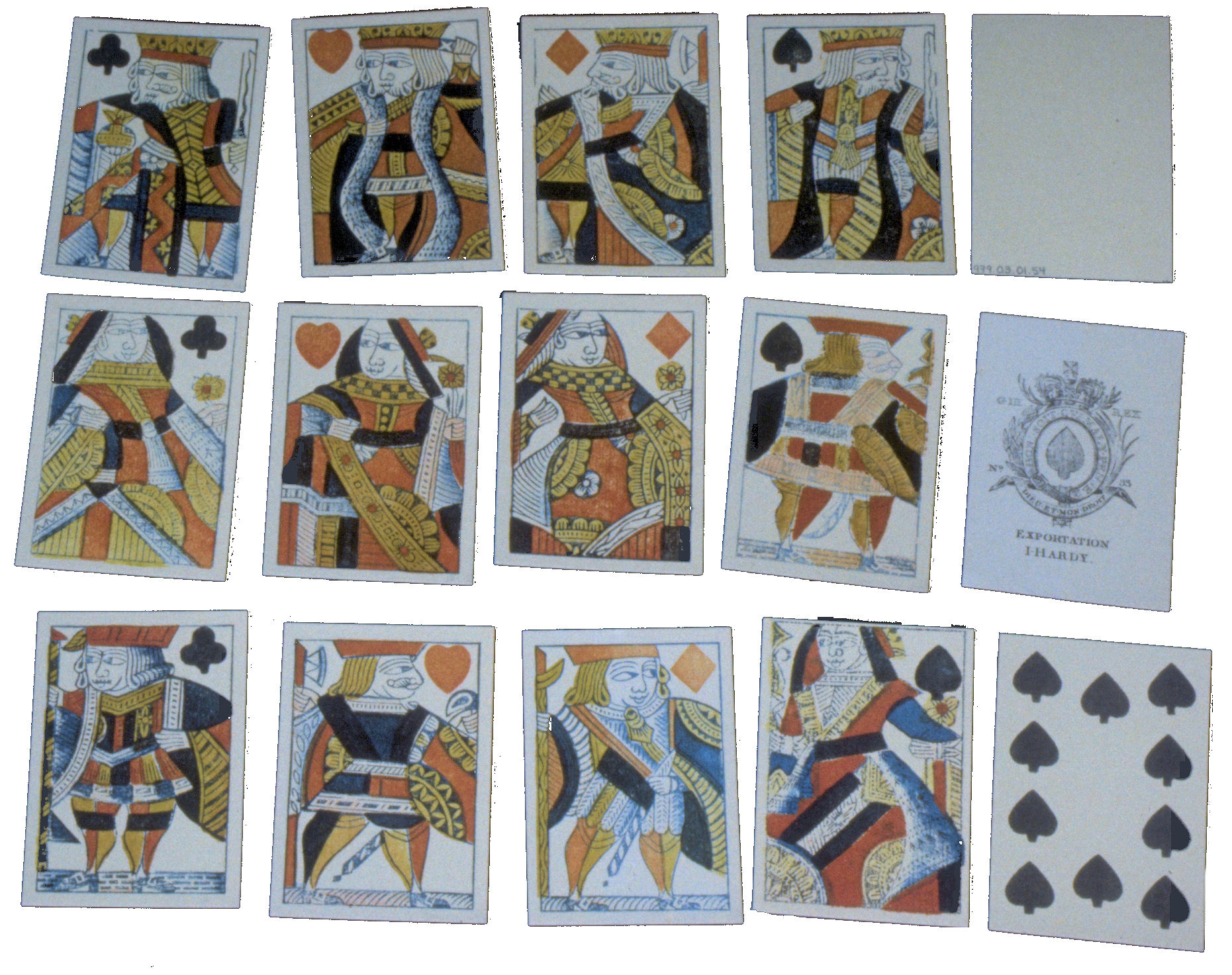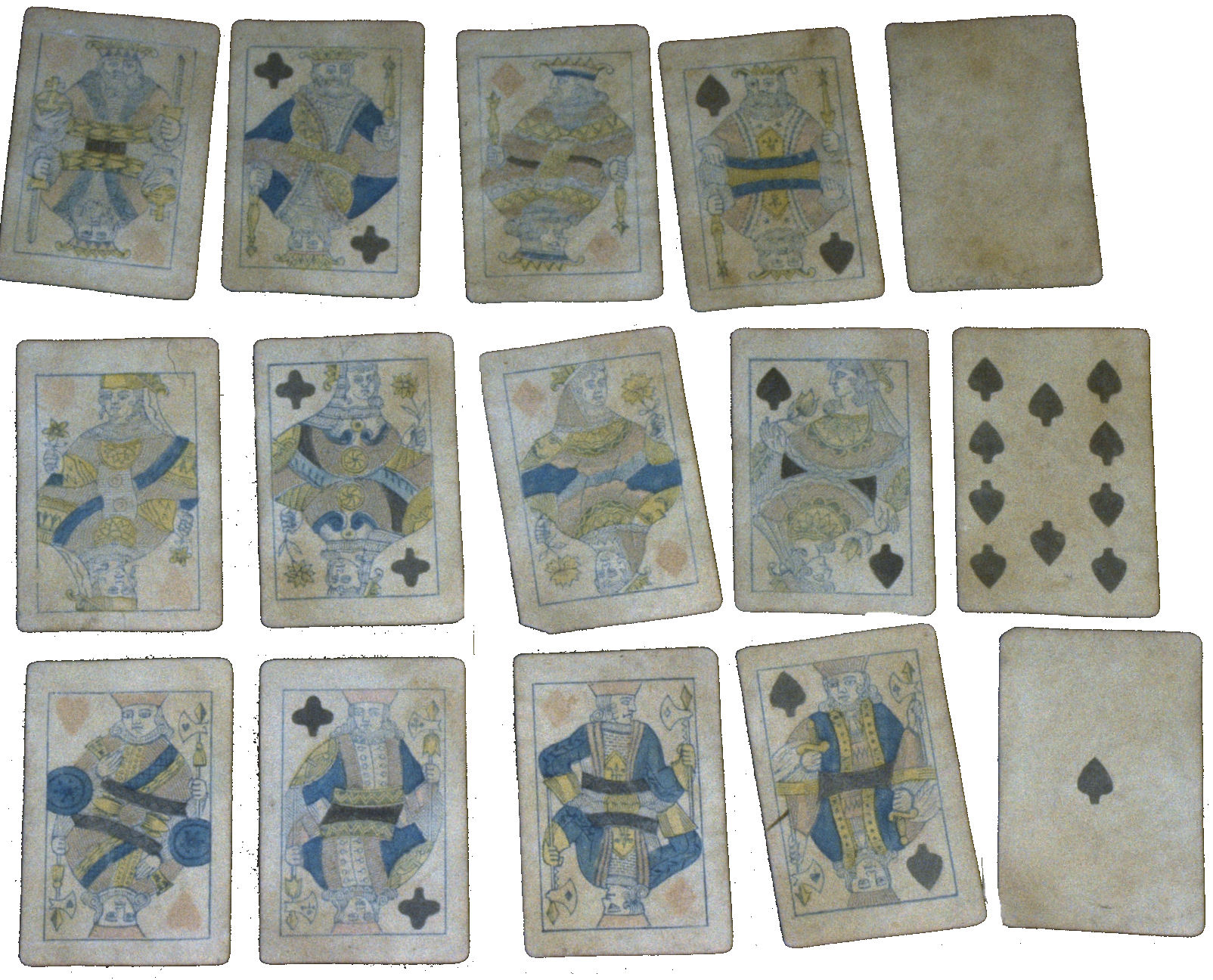
The deck pictured on the left is a reproduction of a deck of playing cards manufactured in England and sold in the British North American Colonies during the 18th century. This reproduction was donated to the collection in 1979. During this Colonial Period, it was illegal for decks to be manufactured in the Colonies - they were required to be imported from England. Furthermore, decks could not be resold into England. This information is printed on a brown paper wrapping around the deck. Heavy penalties were imposed if the legalities were violated. The reason - the British charged the Colonies a special "Excise Tax" on purchase of playing cards - not for moral reasons - but for economic reasons.
The cards are block printed on soft cardboard. A number of wood blocks were inscribed with images by hand, and cards having multiple colors resulted from the use of more than one block. Each card measures 9.5cm long x 6.5cm wide. The backs are unmarked as may be seen in the upper right of the photograph. Suit colors are in the French style, face cards are "single headed" court figures, and there are only 3 face cards per suit. Also it is noted that the "numbered" cards are not numbered, but have the appropriate number of suit symbols indicating a card's value; see the 10 of spades for example (bottom right). Kings have suit markings in the upper right, while the placement of suit markings vary for the Queens and "knaves" (Jacks). The card pictured in the center right is a reproduction of the official card maker's seal.

The deck partially pictured on the right looks somewhat similar to the reproduction shown above. This deck however, was donated to the collection in 1979. It had belonged to a sea captain named John Galt whose family lived in Williamsburg, Virginia (US). The deck was found in the basement of the family home (in the section know as "Colonial Williamsburg"), many years after Captain Galt had died.
The donor could not be specific as to when Captain Galt had died. As can be seen, the deck is badly soiled. The deck accompanied a "Cribbage" board which supposedly was used with the deck at sea by Captain Galt. Thus, this deck may be an original deck, imported from England to the Colonies, or it might be just another type of reproduction which was used by Captain Galt. No attempt to identify the age of the deck has been made at this time.

The British continued to use the international suit indicators in playing card manufacture throughout the British Empire. Thus, standard North American manufactured decks today use the international indicators on playing cards, as do decks in other parts of the former British Empire.
The deck pictured at the left (partial view) was manufactured by Charles Goodall & Sons, Ltd. in London, England about 1890. It was donated to the collection in 1982. The deck was created to honor the then Princess Mary. She is pictured on the back of each card.
The cards (8.9cm long x 5.7cm wide) are similar to cards used today. They continued to be based upon the international pattern. The deck is a standard English 52 card deck.
The cards sit in a plain white stiff cardboard inner box (9.1cm long x 6.2cm wide x 1.8cm thick), which is covered by an outer box. The outer box is covered with a white textured material and printed with information about the deck. On the base of the inner box is an orange stamp stating "Inland Revenue". On the stamp is the head of a bearded man (the then king), and around this head are the words "Fifteen Cents Excise Tax".

The circular deck pictured on the right was purchased in England in 1976. It was manufactured by John Waddington, Ltd., Leeds & London.
As one examines the history of playing cards, some scholars indicate that long before playing cards were seen in Europe or the British Isles, they could be found in Persia and India. Some of these were suited circular decks, used for a game called Ganjifa, played in India. The deck pictured is not a Ganjifa deck since the suit indicators and the face cards are of the international type. Further more, all of the face cards are quadruple-sided, and all cards have quadruple suit indicators. Thus, it may be assumed that this deck was intended to be sold, not to commemorate Ganjifa cards - but to be sold as a novelty!
Each card is 7.1cm in diameter. There are 2 decks of 54 cards each - 52 standard cards and 2 jokers. Card backs are pictured upper right, and the card box (8.7cm long x 16.5cm wide x 2cm thick) is seen at the top of the picture. Attempting to hold a Bridge hand of 13 circular cards such as these might be somewhat cumbersome; however, such cards might make excellent coasters for beverages!
NOTE: This page was originally created and posted on the Web on February 18, 1995. Subsequently it has been modified and periodically updated. Last update: June 11, 2010